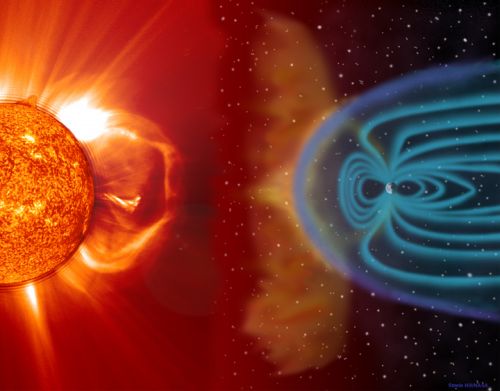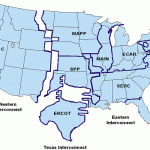This report has been compiled to assist Canadian critical infrastructure (CI) owners and operators with their emergency management planning by discussing how geomagnetic storms can impact CI and by addressing ways in which industry can mitigate the impacts of these potentially dangerous storms. This report also illustrates some of the proactive practices that Canadian industry has implemented to avoid prolonged negative effects from geomagnetic storms. This document was derived primarily from open sources and draws on a variety of public and private information current to 29 April 2002.
Executive Summary
Geomagnetic storms have the potential to severely impair critical infrastructure.
Consequences of geomagnetic storm activity can include widespread power failures, pipeline corrosion, the shutdown of cable systems, an increased drag on satellites, inaccurate navigational sensors and the loss of millions of dollars in revenue.
In Canada, it has been demonstrated that power systems, pipelines and communications are at risk from the damaging effects of coronal mass ejections (CME) and geomagnetically induced currents (GIC).
Canadian infrastructure owners and operators have developed effective operating procedures to deal with the threat of geomagnetic storms. Advance warning systems provide infrastructure owners and operators with the necessary information to prevent the negative consequences of GICs through the implementation of proactive conservative operating procedures.
Background
The phenomenon of geomagnetic currents was first noticed in 1847. In this year, the telegraph was the primary method of communication and relied on batteries for power. Once, however, while an Aurora Borealis was occurring, telegraph operators observed a disruption in the transmission of communications. When the power was switched off, the geomagnetically induced currents (GIC) 1 or “celestial power” allowed transmissions to be conducted at a better quality than with the use of batteries.
GICs are a result of erupting sunspots. Sunspots are massive dark areas on the surface of the sun that lie on top of hurricanes of electrified gas. When sunspots erupt, they release a coronal mass ejection (CME) 2 at approximately 2 million miles per hour. Geomagnetic storms occur when the CME impacts the Earth’s magnetosphere, thereby disturbing the solar wind and reducing the global magnetic field. While these powerful storms usually trigger auroras, they can also damage energy and communication systems.
1 According to Faraday’s law of induction, a temporal change of a magnetic field is always accompanied by an electric field. Therefore, an electric field is associated with geomagnetic activity. The geomagnetic variation and the geoelectric field observed at the earth’s surface depend primarily on ionospheric-magnetospheric currents and secondarily on currents and charges induced in earth. A part of the earth currents can flow into man-made conductors, like power transmission systems, pipelines, telecommunication cables and railroads. Such currents are called geomagnetically induced currents (GIC).
2 An observable change in coronal structure that occurs on a time scale between a few minutes and several hours, and involves the appearance of a new, discrete, bright white-light feature in the coronograph field of view. They are associated with the large-scale, closed magnetic structures in the corona. When a coronal mass ejection occurs, a large quantity of material (10^15 – 10^16 g) is sporadically ejected from the Sun into interplanetary space. The speed of the leading edge of the coronal mass ejection may vary from 50 km/s to 1200 km/s. Average speed is about 400 km/s. The average heliocentric width is about 45 degrees. Large geomagnetic storms are caused by coronal mass ejections.
Introduction
Since 1940, there have been formidable geomagnetic storm events. An intense storm on Easter Sunday 1940 affected both the telegraph and power systems in North America. The storm compromised nearly all overseas radiotelephone circuits, radio service to ships at sea and several long distance land telephone transmissions. The negative effects on land lasted for approximately 6 hours.
Considered one of the worst geomagnetic storms of the 20th century, another noteworthy geomagnetic event with severe consequences for Canada’s energy sector occurred on March 13, 1989. At 02:45 EST on March 13, geomagnetically induced currents (GIC) inundated the transformers of the Hydro-Quebec power system and overloaded them with current. The voltage fluctuations that resulted prompted the tripping, or deactivation, of reactive power compensators at the Chibougamau, la Verendrye, Nemiscau and Albanel substations. A severe voltage drop resulted, the power lines from James Bay malfunctioned and the system collapsed. It was later determined that the power lines were substantially vulnerable due to their great length and the number of static compensators that run along their distance. Static compensators stabilize the power system and allow more AC power to flow through, creating a higher efficiency in the system. When compensators trip out, however, the system becomes unstable. In the end, approximately 19, 400 megawatts of power in Quebec, and millions of dollars in revenue, had been lost. Restoration of services took approximately nine hours; however, by noon on March 13, 17 per cent of Hydro-Quebec’s customers were still without power.
Storms of less severity occurred in September 1989, March 1991 and October 1991, but they were still strong enough to hinder utility operations. These events have caused industry to become more aware of the reality of geomagnetic storms and the destruction they can wreak on unprepared infrastructure components.
Solar Cycles are consecutive groups of geomagnetic storm activity that repeat approximately every 11 years. Solar Cycle 22 occurred between September 1986 and May 1996. Currently, we are in Solar Cycle 23 and April 2000 was thought to be the peak of this cycle’s activity. Recently, it was discovered that Solar Cycle 23 is peaking for the second time. The second peak of this cycle appears to be only a few percent smaller than the first peak. This double-peaking phenomenon was last observed during Solar Cycle 22. The first peak occurred in 1989 and the second peak occurred in 1991. Past observations have indicated that odd numbered solar cycles are more severe than even numbered ones. Since events of the last solar cycle were above average, it can be expected that the current cycle has the potential to be severe as well.
In the following paragraphs, two major infrastructure groups will be discussed: energy and communications. The discussions will include the effects of geomagnetic activity on energy and communications, the extent to which these infrastructures are vulnerable to geomagnetic storms, and the action that can be taken to minimize the negative effects of GICs. This paper will also explore various practises that Canadian industry is utilising to mitigate effects of geomagnetic storms on Canada’s critical infrastructure.
Energy
During a geomagnetic storm, several important elements of the energy sector can suffer adverse effects if they are not protected. Intense electric currents flowing throughout the ionosphere can induce voltage surges on power grids, trigger the melting or malfunctioning of transformers and cause the overloading of electrical grids. As a consequence of this activity, blackout conditions can result over a large area and pipelines can suffer cumulative damage from corrosion.
Power Systems
Geomagnetic storms can affect power operations when GICs flow through power lines to substation transformers, saturating the transformer core with electricity. The extra voltage fluctuations produced in the transformer cause relay operations that can suddenly prevent power lines from functioning. As well, the stability of the entire system can be compromised when compensators switch out of service due to irregularities in voltage levels.
Power stations may experience increased vulnerability due to advances in technology. Modern power systems are interconnected in such a way that they are quite stable and are safeguarded against localized failures. This interconnectedness, however, can lead to increased vulnerability in some circumstances. When a solar storm damages one system, systems connected to it can experience failure as well. Also, some systems that experienced problems during the last peak in Solar Cycle 22 may be stressed because they are currently increasing the electrical load on their systems and, in turn, can be more affected by geomagnetic events that happen during Solar Cycle 23.
Preventative measures have been implemented to avoid events such as the 1989 Quebec blackout. System operators in Canada have developed and implemented procedures to respond to these emergencies, thereby reducing potential damage due to GICs. Since 1989, Hydro-Quebec has spent more than $1.2 billion installing transmission line series capacitors. These capacitors block GIC flow in order to prevent them from causing damage to the system. Hydro-Quebec has also installed monitoring equipment that spots voltage fluctuations and immediately notifies operators so that they may redistribute the load to other parts of the network. Additional protective measures include disconnecting the links between power grids, desensitizing automatic control systems, delaying power station maintenance and delaying the replacement of equipment. Utilities are also relying on space weather forecasting to help remain operational during geomagnetic storms. Operators can implement conservative operating procedures once they have received an advance warning of a storm threat.
Pipelines
Geomagnetic storms have the ability to cause cumulative damage to pipelines, in the form of corrosion. Significant efforts have focused on reducing corrosion by maintaining pipelines at a negative voltage relative to surrounding soil. Electric currents induced by geomagnetic field variations can cause large voltage fluctuations damaging the pipeline and initiating corrosion. These electric currents are driven along the pipe resulting in the build-up of current that raises the electric potential at the end of the pipe and creates a potential gradient that drives the charge back along its length. In addition, some of this charge build-up can leak into surrounding soil through the pipeline’s electrical insulator coating. This leak can cause changes in the charge build-up and initiate fluctuations in the pipeline’s electric potential. As a result, the corrosion process is initiated and the pipeline will suffer cumulative damage over time.
Pipelines that have insulating flanges can be more vulnerable to damaging electric currents. The flanges are meant to interrupt current flow; however, it has been discovered that the flanges create an additional site where the electric potential can build up and force the current flow to ground. The flanges lead to an increased risk for corrosion. The length of the pipeline also adds to its vulnerability due to the increased potential for corrosion.
The geomagnetic dimension of corrosion protection design and the monitoring of pipelines is being recognized as a topic that requires immediate attention. Canadian pipeline operators were among the first to recognize that geomagnetic storms negatively affect pipelines and are world leaders in the design of systems that mitigate possible impacts. Mitigation activities include simulating electric currents in pipeline networks and pre-designing corrosion protection systems that have the ability to properly deal with geomagnetic effects. This work, combined with frequent monitoring, can help to avoid the long-term cumulative effects of GICs on pipelines.
Geological Perspective
A geological perspective is useful in determining which energy systems will be more vulnerable to GICs. System vulnerability can be increased because GICs from geomagnetic storms have the ability to induce an electrical charge in a rock deposit. An example of such a rock deposit is the North American Central Plains (NACP) anomaly. It is one of the world’s longest strips of conductive rock, which winds underground from Wyoming through Saskatchewan and Manitoba to the Hudson Bay area. It is extremely conductive because of the presence of sulphides and graphite, which make it up to 1000 times more conductive than the surrounding Canadian Shield. Critical infrastructure elements that are positioned in or on the anomaly may be at increased risk to GIC’s due to the high electrical conductivity of the rock. Currently, a detailed map of the electrical conductivity running through the Manitoba portion of the NACP is being developed. This map will help power and pipeline companies better predict how the North American power and pipeline grids can be affected during a geomagnetic storm event.
Communication
Communication technology can be vulnerable to the effects of a geomagnetic storm. Since the introduction of coaxial cables in the 20th century, the bandwidth of communication systems has increased but cables now require repeater amplifiers along their length. These amplifiers compensate for the loss of signal strength over distance and are connected in series with the centre conductor of the cable. Amplifiers are powered by a direct current supplied from terminal stations at either ends of the cable. The varying magnetic field that occurs during a geomagnetic storm induces a voltage into the centre of the coaxial cable increasing or decreasing the voltage coming from the cable power supply. The induced voltage experienced during a geomagnetic storm can produce an overload of electricity on the cable system and, in turn, cause a high current shutdown.
Submarine cables are now using optical fibres to carry communication signals; however, there is still a conductor through the cable that carries power to the repeaters. Cables installed in the future may use fewer repeaters and require a lower driving voltage, which will assist in reducing the negative impact of a geomagnetic storm. If the power feed equipment, however, is downsized without considering the induced voltages, communication systems will become more vulnerable.
Geomagnetic storms can also impact satellites and spacecrafts. Geosynchronous satellites are at risk of being exposed to a hostile environment. Changes in the Earth’s magnetic field confuse navigational sensors such as the Global Positioning System (GPS) and the sensors on satellites. Satellites can experience orbital decay problems such as increased drag, as a result of the increasing atmospheric temperature and subsequent expansion.
Protons and electrons become extremely energized when contacted with solar flares or CMEs. When these solar particle events are fired toward the Earth, they are capable of damaging spacecraft microelectronics or solar cells in one collision. These events can intensify radiation inside a spacecraft with severe or even lethal consequences. Mitigation efforts regarding space activities include putting satellites to “sleep”, turning sensitive spacecraft subsystems off, increasing satellite monitoring for anomalies and calculating the best time to adjust a low Earth orbit for drag. Space flight activities can also be delayed in order to avoid exposing astronauts to dangerous levels of radiation.
Aerial navigation systems can also be damaged by geomagnetic storms. In order to minimize negative effects from GICs, the flight altitude on polar routes can be adjusted to minimize health hazards and alternatives to GPS-based takeoff and landing procedures can be implemented.
Surveying practices rely heavily on technology for activities such as mapping. This sensitive technology, however, can be vulnerable to the effects of GICs. In order to safeguard surveying activities, and avoid magnetic disturbances that can produce false results, high-resolution land surveying, magnetic surveying and exploration can be delayed until the threat from GICs is no longer significant.
The communications industry in Canada is working toward mitigating impacts from geomagnetic storms. Many of the suggested remedies mentioned above are being practised in order to reduce negative effects from GICs. In addition to this, they are relying on space weather forecasting to indicate when conservative operating procedures should be initiated.
Advance Warning Systems
The prediction and advance warning of geomagnetic storms assist industry and public in avoiding adverse effects of GICs. There have been numerous technologies developed that gather data to support prediction activities. For example, x-ray based observations provide a very detailed and inclusive picture of the magnetic structure of the sun and its CMEs. This tool provides forecasts two to three days in advance with approximately 50 per cent accuracy.
One of the most reliable forecasting tools is the Solar and Heliospheric Observatory (SOHO), which was launched by the National Aeronautics and Space Administration (NASA) and the European Space Agency (ESA) on 2 December 1995. This satellite provides images of large eruptions on the surface of the sun and is considered to be a valuable tool in the field of space weather forecasting.
NASA’s Advanced Composition Explorer (ACE) satellite is a forecasting tool which is expected to produce exceptional results. It was launched on 25 August 1997 and is positioned approximately 1.5 million kilometres from Earth. It is monitoring the content of the solar wind and aims to provide space weather warnings one hour in advance with extreme accuracy. In November 2001, ACE reported on two solar energetic particle (SEP) events that turned out to be the largest of Solar Cycle 23.
In addition to these three tools, new accurate warning devices are being developed to predict potential storm impact, and to assess the appropriate response measures to be used by critical infrastructure owners and operators.
Conclusion
Geomagnetic storms, although infrequent, have the potential to severely impair critical infrastructure. In Canada, it has been demonstrated that power systems, pipelines and communications are at risk from the damaging effects of CMEs and GICs. Consequences of geomagnetic storm activity can include widespread power failures, pipeline corrosion, the shutdown of cable systems, an increased drag on satellites, inaccurate navigational sensors and the loss of millions of dollars in revenue.
Canadian infrastructure owners and operators have developed effective operating procedures to deal with the threat of geomagnetic storms. Also, advance warning systems such as ACE and SOHO are providing infrastructure owners and operators with the necessary information to prevent negative consequences due to GICs.
References
Appell, D. (1999). CMEs-If the Sun Spits, The Earth Could Fry. Retrieved February 19, 2002, from: www.rense.com/earthchanges/sunspit.htm
Boteler, D.H. (2001). Assessment of Geomagnetic Hazard to Power Systems in Canada. Natural Hazards 23: 101-120.
Boteler, D.H. (2001). Geomagnetic Hazards; in A Synthesis of Geological Hazards in Canada, (ed.) G.R. Brooks; Geological Survey of Canada, Bulletin 548, p.183-206.
Boteler, D.H. Geomagnetic Hazards to Electrical Systems. Submitted to Journal of Natural Hazards for publication in 2002.
Christian, E.R. (1998). Advanced Composition Explorer (ACE) Home Page. Retrieved November 26, 2001, from the California Institute of Technology Space Radiation Laboratory web site: http://www.srl.caltech.edu/ACE/
Cohen, C., Mewaldt, R., Zwickl, R. (2001). ACE News #57-November, 2001 Features Two of the Largest Solar Particle Events of Solar Cycle 23. Retrieved December 10, 2001, from the California Institute of Technology Space Radiation Laboratory web site: http://www.srl.caltech.edu/ACE/ACENews/ACENews57.html
Consequences of Intense Geomagnetic Storms, Space Science & Satellite Applications. (Date Unknown). Retrieved November 26, 2001, from the Department of Atmospheric, Oceanic and Space Sciences (AOSS) at the University of Michigan’s web site: http://aoss.engin.umich.edu/earth_space/storms8.html
E.S. Electric Rock. (2001, Nov/Dec). Canadian Geographic, Canadian Geographic Enterprises, p.32.
Flange. (2000). The American Heritage? Dictionary of the English Language: Fourth Edition. Retrieved from Bartleby: http://www.bartleby.com/61/55/F0165500.html
Geomagnetic Effects on Communication Cables. (1998). Natural Resources Canada. Retrieved November 26, 2001, from http://www.geomag.nrcan.gc.ca/geomag/e_cable.html
Geomagnetic Effects on Pipelines. (1998). Natural Resources Canada. Retrieved November 26, 2001, from http://www.geomag.nrcan.gc.ca/geomag/e_pipeline.html
Geomagnetic Effects on Power Systems. (1998). Natural Resources Canada. Retrieved November 26, 2001, from http://www.geomag.nrcan.gc.ca/geomag/e_power.html
Geomagnetic Storms. (Date Unknown). Retrieved November 26, 2001, from the Department of Atmospheric, Oceanic and Space Sciences (AOSS) at the University of Michigan’s web site: http://aoss.engin.umich.edu/earth_space/images/storms1.gif
Green, Arthur W., Brown III, William M. (Date Unknown). Reducing the Risk from Geomagnetic Hazards: On the Watch for Geomagnetic Storms. Retrieved November 26, 2001, from http://geohazards.cr.usgs.gov/factsheets/html_files/geomag/geomag.html
Gurman, J.B. (2001). The Mission-About: A Description of the SOHO Mission. Retrieved January 3, 2002, from The Solar and Heliospheric Observatory (SOHO) Homepage: http://sohowww.nascom.nasa.gov/
Gurman, J.B. (2001). The Mission-About: An Uninterrupted View of the Sun. Retrieved January 3, 2002, from The Solar and Heliospheric Observatory (SOHO) Homepage: http://sohowww.nascom.nasa.gov/
History of Geomagnetic Effects. (1998). Natural Resources Canada. Retrieved November 26, 2001, from http://www.geomag.nrcan.gc.ca/geomag/e_history-1.html
Kappenman, John G. (1996). Geomagnetic Storms and Impacts on Power Systems: Lessons Learned from Solar Cycle 22 and Outlook for Solar Cycle 23. Minnesota Power Electric. Retrieved November 26, 2001, from http://www.mpelectric.com/storms/
Kappenman, John G., Zanetti, Lawrence J., Radasky, William A. (1997). Geomagnetic Storms Can Threaten Electric Power Grid, Earth in Space, pp. 9-11. Retrieved December 4, 2001, from the American Geophysical Union database: http://www.agu.org/sci_soc/eiskappenman.html
Phillips, Dr. T. (2002). The Resurgent Sun. Retrieved January 29, 2002, from the Science @ NASA web site: http://science.nasa.gov/headlines/y2002/18jan_solarback.htm
Phillips, Dr. T. (2001). What Lies Beneath a Sunspot. Retrieved January 24, 2002 from the Science @ NASA web site: http://science.nasa.gov/headlines/y2001/ast07nov_1.htm
Space Today Online. (2002). The Sun. Retrieved January 24, 2002, from http://www.spacetoday.org/SolSys/Sun/Sunspots.html
Thompson, Richard. (1995). Power Failure in Canada During 1989. IPS Radio & Space Services. Retrieved November 26, 2001, from http://www.ips.gov.au/papers/richard/power_1989.html
More From SolarStorms.org:
Submit your review | |






